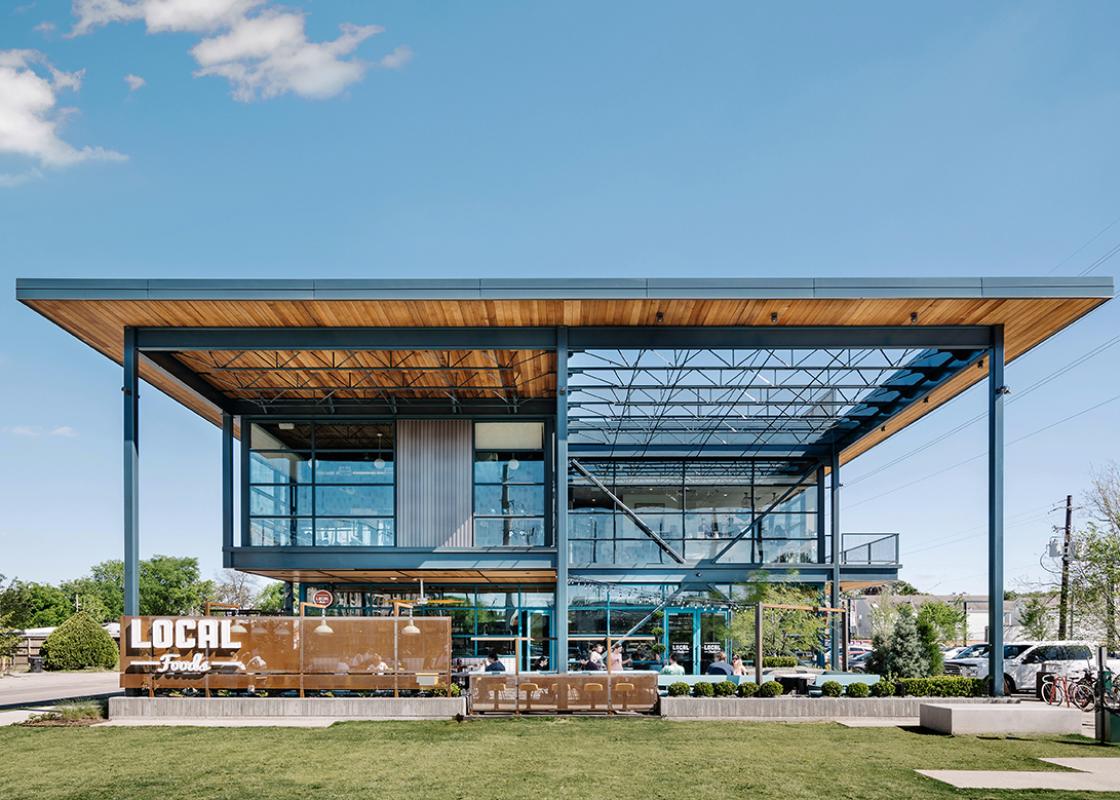Steve Radom is Managing Principal of Radom Capital. Cynthia Dehlavi is Research and Design Associate with OJB Landscape Architecture.
Cynthia Dehlavi: I am a big fan of your Heights Mercantile development. Can you tell me how you got started? It is much larger in scale than some of your other work.
Steve Radom: Heights Mercantile was a collaborative effort. The first parcel was acquired and then we found six other sellers for properties in or around that first purchase. It fronts the MKT Heights Bike Trail and Heights Boulevard, and it is across the street from Donovan Park. The property was an opportunity hiding in plain sight.
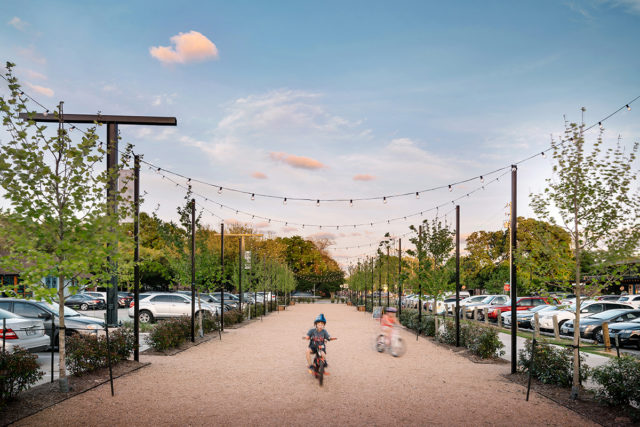 Festoon lights covering the tree-lined promenade celebrate the connection of Heights Mercantile with the Heights bike trail. Photo: Chase Daniel.
Festoon lights covering the tree-lined promenade celebrate the connection of Heights Mercantile with the Heights bike trail. Photo: Chase Daniel.
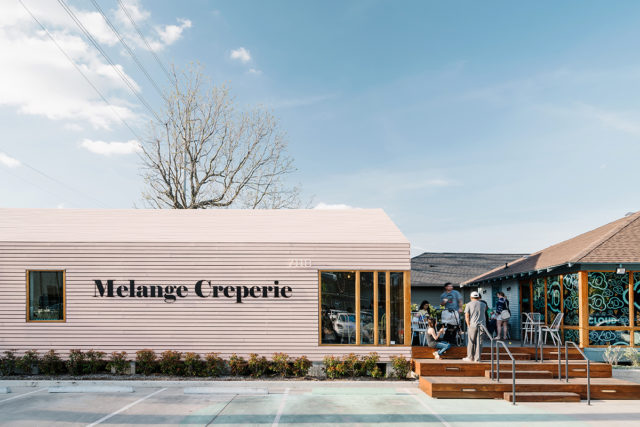 Located at the center of the development, this shotgun-style building in millennial pink has a major “cool” factor. Photo: Chase Daniel.
Located at the center of the development, this shotgun-style building in millennial pink has a major “cool” factor. Photo: Chase Daniel.
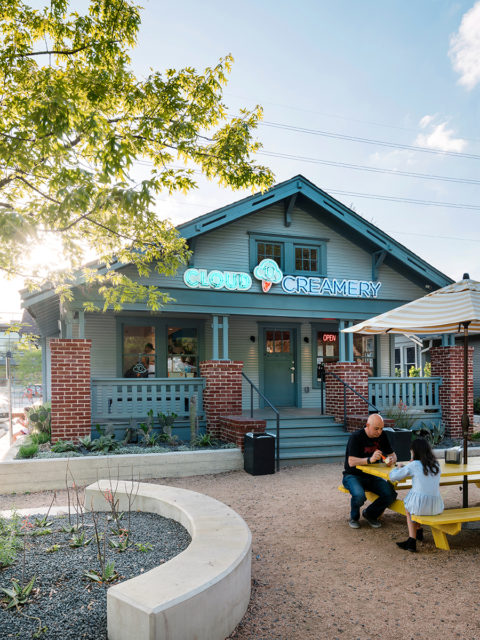 Heights Boulevard maintains a residential-type frontage blending the development with the neighborhood. Photo: Chase Daniel.
Heights Boulevard maintains a residential-type frontage blending the development with the neighborhood. Photo: Chase Daniel.
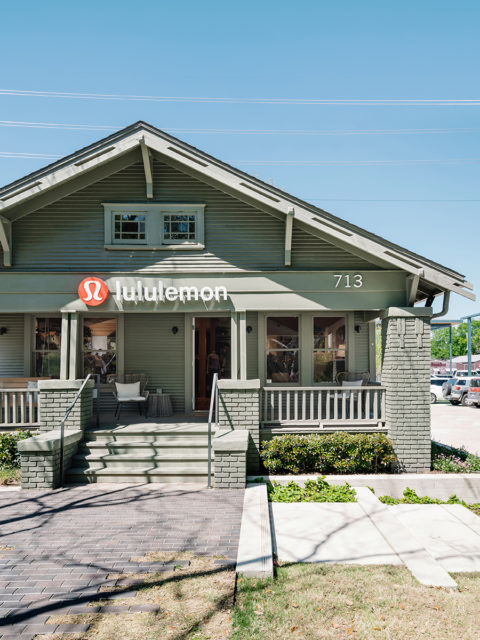 Another example of a residential-type building facing Heights Boulevard. Photo: Chase Daniel.
Another example of a residential-type building facing Heights Boulevard. Photo: Chase Daniel.
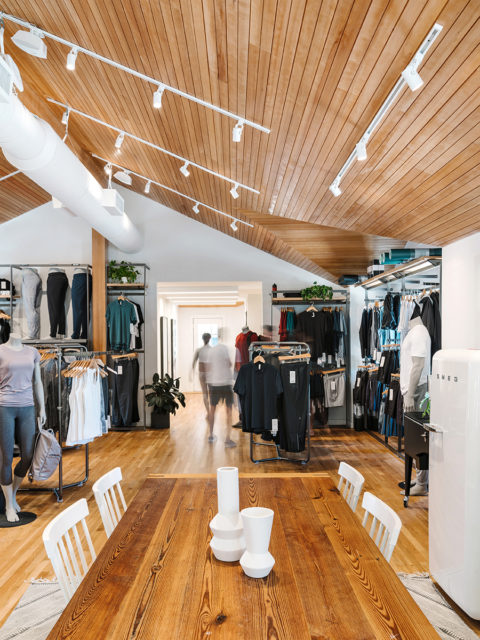 Lululemon interior inside a Heights bungalow. Photo: Chase Daniel.
Lululemon interior inside a Heights bungalow. Photo: Chase Daniel.
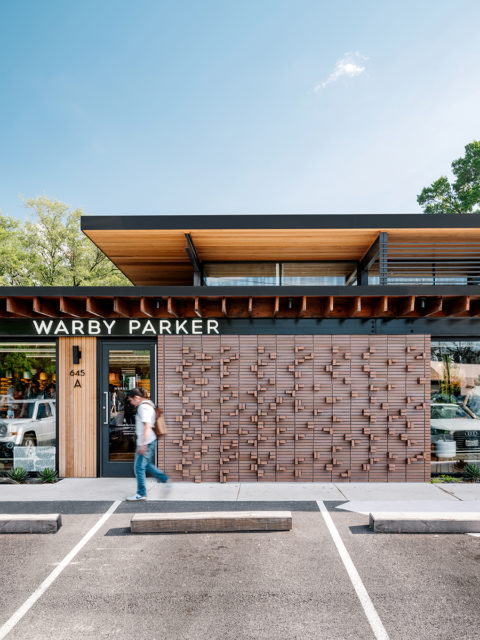 Outside Warby Park, the brick façade is inspired by a braille pattern. Photo: Chase Daniel.
Outside Warby Park, the brick façade is inspired by a braille pattern. Photo: Chase Daniel.
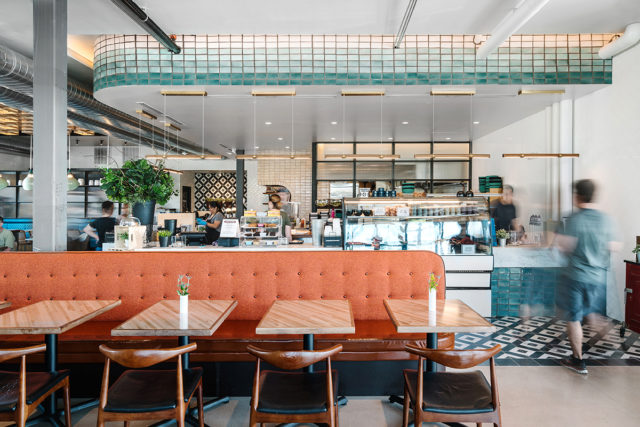 The mid-century modern interior at Local Foods is an aesthetic match for the shopping center. Photo: Chase Daniel.
The mid-century modern interior at Local Foods is an aesthetic match for the shopping center. Photo: Chase Daniel.
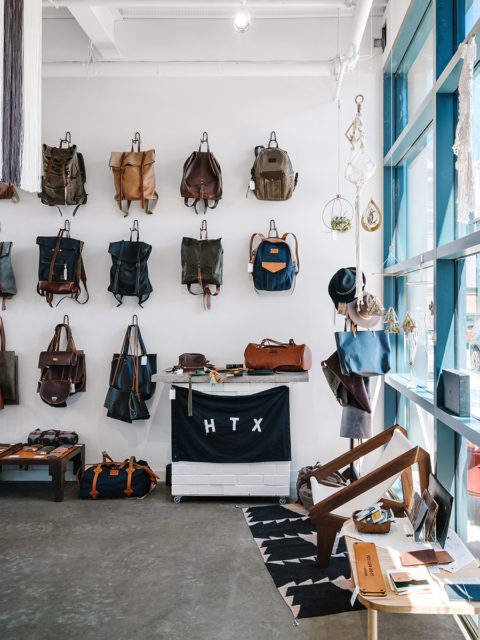 A view inside a shop dedicated to local artisans, HTX proud. Photo: Chase Daniel.
A view inside a shop dedicated to local artisans, HTX proud. Photo: Chase Daniel.
The concept is pretty simple: Heights Mercantile is at the gateway to the Heights. Joggers, bikers, and families coming to the park — they were already coming to the entrance to the property. It struck us as an opportunity to take something in the heart of an active, fitness-based part of Houston, and provide reasons for them to not just run by, but to come in and engage the property.
I love the project because of its small but impactful scale. We deliberately focused on green spaces and embracing a diversity of architecture, with everything from 1920s Sears Craftsman bungalows that are contributing historical structures to a brand new modernist jewel-box building that is reminiscent of the Eames house in Santa Monica, California.
This development isn’t just another restaurant enclave but one that has retail, fitness, a little bit of beauty, to go with the restaurants. It took a lot of stubborn effort, a lot of shoe leather to make it work. The challenge wasn’t just persuading one person to come here as there are 20 different tenants. We had to educate each of them as to why this scrappy little project was a better fit for them than larger, more capitalized projects. We had to convince them that we would deliver something that would not just look like the rendering but would be better than it, and explain that we would have programming that is unique and supportive of the community. There was a lot of work behind the scenes, but most commentators note that Heights Mercantile popped up overnight.
CD: It feels like it did.
SR: To be fair, it did largely come online at the same time – but that was deliberate. Ideally, businesses and visitors don’t want to arrive in the midst of a ton of construction. So it all was in the works for years very quietly behind the scenes.
CD: Could you tell me how you came to do this type of work?
SR: I grew up in a small family real estate business where we all helped however we could, both in the office and at the property. After a few summers working outside on roofs in Houston or moving office furniture out of a building, all of a sudden a desk job sounded amazing.
I went to the University of Texas for my undergraduate and master’s degree in accounting, and my law degree. I was a practicing CPA for about a year and a half out of school at PricewaterhouseCoopers and then I worked at Skadden, a New York-based law firm. Then I went back to the family business in 2006.
I’ve always desired to develop in areas I personally wanted to go to. I realized that when I started my own company in 2014 that I only wanted to invest my time in the places I was passionate about and that I wanted to be around. Ideally, your work week can be spent in cool urban environments. So thematically, I began trying to find redevelopment opportunity in areas that had a misalignment. In an area like the Heights — this was very true five years ago — you saw this amazing residential infrastructure, this great stock of homes that had been painstakingly restored and tasteful new construction projects, and this great wave of residents that had disposable income but also had an urban character to them with very few places to go in their neighborhood. The commercial infrastructure felt misaligned. The needs of the people living in the area were not met with the commercial offerings across the street. So we challenged ourselves to think about what the neighborhood would want and what it was missing. The goal has always been to quietly catalyze a block or a street in an urban acupuncture approach.
CD: That is interesting, first, working on projects you like and admire, you are invested in it. There is a lot of accountability there that is embedded in your work. One thing I’ve heard many times when meeting with developers about new approaches is, we just don’t have a model in Houston for how that would work. It is very frustrating. Who is going to build the model? Who will build it first?
SR: I’ve learned to trust my gut and to not be afraid. Not be afraid to follow the expectations of the herd. If anything, what we try to do, in a measured and subtle way, is to subtly break the rules and not follow what has been done. It forces us to challenge ourselves on every project we have. You can make what you have count by having deliberate decisions. Many developers are not as concerned about the way things look or feel in real life; they are more concerned about how things perform on a model in a spreadsheet. We take the opposite approach. We feel like if we put out a product that is thoughtful and deliberate, even if it does not have a comparable in an area, ultimately we will be vindicated because it will be an anchor for positive outcomes in unexpected ways.
CD: Do you lead the design or do you rely on a design team? How do you get the design results that you have?
SR: It is all of the above. We are very fortunate that we have had the opportunity to work with some of the best architectural minds like Troy Schaum or Michael Hsu. [Disclosure: Troy Schaum is on the board of Cite’s publisher, the Rice Design Alliance.] They are at the top of their game, very attuned to what has happened historically and what has happened in Houston, nationwide, and worldwide. They have a very intellectual and a very pragmatic approach. But still, we do assert ourselves in the design process. We really think about each project holistically and within the confines of the existing street and neighborhood. If we acquire an old industrial building in an area like the Heights, we think it is a mistake to completely whitewash the past. It can be quite beautiful to contrast a raw piece of weathered steel or wood to something that is modern and clean. The effect is more powerful than recreating something bland. It is very much a harmonious conversation. I have the utmost trust in the architects we use but that doesn’t mean we can’t guide the process for the users we want for the project.
CD: I think it is a reciprocating process. The strongest projects come about from the forward-thinking developers.
SR: I completely agree. The best projects are the ones with the strongest team collaborations.
I would be lying if I say I didn’t spend time on Pinterest and try to play architect sometimes. It used to be you would read something in Architectural Digest or a magazine, and tear out a page, and put it in a file. Now you can reference everything you see and catalogue it for future developments. Those files can visually be referenced in the conversations you have.
CD: The founder of Pinterest went to architecture school. He built the forum to share photos with classmates. He dropped out because he created a platform that shot out of control but it started with architecture.
Could you talk more about the vendors you chose at Heights Mercantile? Was there a strategy to make a cool destination?
SR: The underlying theme we had for the project, a name we had considered, was “Independent.” We wanted independent thinkers. While Warby Parker is a national brand, we love Warby Parker because they distanced themselves from this prior expectation that glasses have to be expensive. Warby is both national and a scrappy startup formed a few years ago by these Wharton business school guys at the same time. It is also a socially innovative company because they give glasses away. For $95, you get glasses and lenses, you get high-quality glasses, and they give away a pair in countries that need more glasses.
Ideally we wanted independent, local, first-to-market names. But we also realized that a project with only unknown brands and undercapitalized new concepts would be too much of a risk. So it was all about balance. We wound up with a few desirable brands like Lululemon that people know of and that already have loyal customers and many more new-to-Houston concepts. Once people come, then they can discovery Favor The Kind or Bespoke. The strategy was very much community serving. I have definitely used the word “cool.” Not because there are one or two things to define cool. The Heights has a lot of history, artistry, and originality.
CD: The question I always love to ask, because this is when it gets juicy, is whether there was a big struggle? Did you have a heartbreak moment?
SR: My God. I’ll put it this way. When we started construction, we were twenty percent leased. That’s because we were being stubborn. We were holding out for the right independent, attractive tenants we were working years to get. For every tenant we have, we had three or four that we had a lease in front of that didn’t get signed.
On the construction side we had a lot of issues. We had issues that ate up our contingency. We had a building that had no rebar. It was stacked brick with nothing behind it. We had to bring in a bunch of bracing and rebuild the walls. In the bungalows, we had termite damage and fire damage. We had all kinds of issues with utilities. At any time we could have fallen off the cliff.
You become a better person, a better business person, not in the good times but in the adversity and how you respond to it. Every developer will have problems. It is how you respond and how you learn from them, how you solve them, that makes you how you are.
CD: I always try to tell myself that during a rough day.
SR: In that moment, it is good take a deep breath.
CD: Have you had an ish moment? This is awesome. We are killing it.
SR: I am a self torturer. My whole life, I’ve always put blinders on and strived to achieve things that are arguably not achievable. When I go to a project, all I can see is the need to replace landscape or a paint chip, or an opportunity to keep innovating or improving on signage. I wish I could say there are moments when we pat ourselves on our backs. It is great to hear praise but it fuels me to live up to that praise. So not really.
CD: Do you think you have a prescription for cool? Elements that will guarantee a cool project?
SR: If cool was something that could be defined and bottled it would no longer be cool. There is a reverse snobbery that exists in the Houston urban core. Everyone wants a subtle violation of expectations and norms. For every project, it has to be reflective of the area it is in and what the community would want, and what has not been provided to the community. The way we can be cool, the prescription, would be to never underestimate the importance of being hyperlocal and the details that would connect people to the project. If we did another Heights Mercantile three miles down the road and called it “Something-else Mercantile,” that would dilute the brand.
CD: I agree with you. It also keeps your job interesting. You are always adapting. You haven’t come up with a prescription. I love how you brand your company “Real Estate Dreamers.” Do you have any dreams for Houston?
SR: Houston is one of the most accessible cities. There are no social barriers to be successful in this town. Anyone who works hard and is fair, and has a longterm regard for others, is rewarded. In other cities it is harder for people to come in if they are not third or fourth generation locals of the place. My dream would be that we continue to enhance the cultural landscape here and that extends to real estate development as well. I think for us the real reward would be spurring a movement of people all trying to do the best things and really create a synergistic environment to continue to attract Millennials and quality population growth. We don’t have a natural, beautiful border. We don’t have an ocean or mountains. It is the spirit of the people, but I think it can also be the diversity of the architecture and the creativity of the developers that leads to something that does become noticeable going forward.
CD: What do you mean the cultural landscape?
SR: Not necessarily just museums or nonprofits. Things that enhance society, that encourage people to live better lives and be more active. It can mean little moments, small decisions that become big decisions. It can be about museums but also organic and simple grassroots projects
CD: I wish there were more grassroots projects. You see a lot of big, chunky objects going up lately.
SR: The vertical box is efficient for office space and apartments. But I don’t know if that’s what we want. Not to say every box is a bad thing but the idea of conforming and copying is not what people are craving longterm.
CD: Very cool.
Heights Mercantile Building Credits
Architecture: Michael Hsu Office of Architecture
Landscape Design: SWA
MEP Consultant: Jordan & Skala
Structural Engineers: H2B
Civil Engineers: H2B
Construction: Forney
Project Management: Radom Capital LLC


